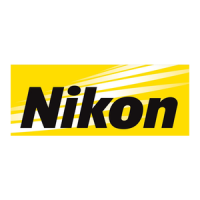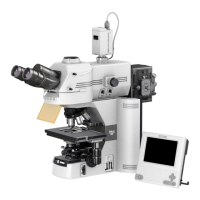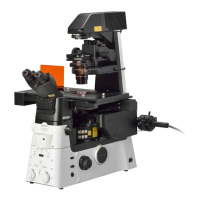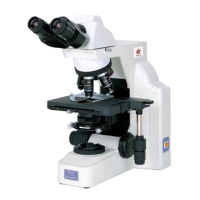What to do if my Nikon ECLIPSE Ei Microscope slide is upside down?
- MMelody BlakeAug 5, 2025
If the slide on your Nikon microscope is upside down, turn it over so that the cover glass faces up.
What to do if my Nikon ECLIPSE Ei Microscope slide is upside down?
If the slide on your Nikon microscope is upside down, turn it over so that the cover glass faces up.
What to do if the objective is not attached correctly to my Nikon ECLIPSE Ei Microscope?
If the objective is not attached correctly to your Nikon microscope, screw the objective all the way in.
What to do if the specimen rises from the stage surface on my Nikon ECLIPSE Ei Microscope?
If the specimen rises from the stage surface on your Nikon microscope, stabilize it using the holder.
What to do if no coverglass is attached to the Nikon ECLIPSE Ei slide?
If no coverglass is attached to the slide for observation with your Nikon microscope, attach a coverglass.
What to do if aperture diaphragm is closed too far on Nikon Microscope?
If the aperture diaphragm is closed too far on your Nikon microscope, open it properly.
How to properly connect the AC adapter to the Nikon microscope?
If the AC adapter is not connected to the microscope main body, insert the DC cord of the AC adapter into the DC input connector.
Explains product symbols, emphasizing caution and referring to manual instructions for safe operation.
Details safety instructions marked with warning/caution symbols to highlight their importance for user safety.
Covers critical warnings: disassembly, input voltage, flammable solvents, and hazardous samples.
Addresses photobiological safety, risk groups, hazard distances, and eye protection measures.
Provides cautions on assembly, handling liquids/foreign matter, moving, and product disposal.
Illustrates and names all microscope parts, including fixing and holding points.
Details the control section, explaining the function of each control, switch, and display.
Guides on installing the microscope, connecting power, and turning it on with initial brightness setting.
Covers adjustments for aperture diaphragm, brightness, interpupillary distance, and diopter ring alignment.
Instructions for placing specimens and achieving initial focus using the 10x objective.
Details changing objectives, diopter adjustment, observing, powering off, and storing the microscope.
Detailed procedures for moving, installing, and storing the microscope, including safety precautions.
Explains specimen placement, movement, and detailed focusing techniques with various objectives.
Covers using higher magnification, oil-immersion, and specific adjustments for optimal observation.
Details control adjustments, optical characteristics, and microscope terminology.
Instructions for removing the fastening plate and adjusting the eyepiece tube orientation.
Guides on attaching the camera mount, installing eyepieces, objectives, and the condenser.
Details connecting the AC adapter and power cord, and handling other accessories.
Provides solutions for common optical problems like dirt, poor image quality, and focusing issues.
Addresses operational issues such as focusing problems, objective contact, and image integration.
Offers steps to resolve electrical problems like illumination failure or unstable brightness.
Instructions for cleaning lenses, the microscope body, and disinfecting after sample spills.
Guidelines for proper storage and information on recommended periodical inspections.
Explains the fundamental principles of microscopy and the intended applications of the product.
Details the key performance specifications, optical systems, and focusing mechanisms of the microscope.
Lists physical characteristics, environmental conditions, and compliance with safety and regulatory standards.
Explains product symbols, emphasizing caution and referring to manual instructions for safe operation.
Details safety instructions marked with warning/caution symbols to highlight their importance for user safety.
Covers critical warnings: disassembly, input voltage, flammable solvents, and hazardous samples.
Addresses photobiological safety, risk groups, hazard distances, and eye protection measures.
Provides cautions on assembly, handling liquids/foreign matter, moving, and product disposal.
Illustrates and names all microscope parts, including fixing and holding points.
Details the control section, explaining the function of each control, switch, and display.
Guides on installing the microscope, connecting power, and turning it on with initial brightness setting.
Covers adjustments for aperture diaphragm, brightness, interpupillary distance, and diopter ring alignment.
Instructions for placing specimens and achieving initial focus using the 10x objective.
Details changing objectives, diopter adjustment, observing, powering off, and storing the microscope.
Detailed procedures for moving, installing, and storing the microscope, including safety precautions.
Explains specimen placement, movement, and detailed focusing techniques with various objectives.
Covers using higher magnification, oil-immersion, and specific adjustments for optimal observation.
Details control adjustments, optical characteristics, and microscope terminology.
Instructions for removing the fastening plate and adjusting the eyepiece tube orientation.
Guides on attaching the camera mount, installing eyepieces, objectives, and the condenser.
Details connecting the AC adapter and power cord, and handling other accessories.
Provides solutions for common optical problems like dirt, poor image quality, and focusing issues.
Addresses operational issues such as focusing problems, objective contact, and image integration.
Offers steps to resolve electrical problems like illumination failure or unstable brightness.
Instructions for cleaning lenses, the microscope body, and disinfecting after sample spills.
Guidelines for proper storage and information on recommended periodical inspections.
Explains the fundamental principles of microscopy and the intended applications of the product.
Details the key performance specifications, optical systems, and focusing mechanisms of the microscope.
Lists physical characteristics, environmental conditions, and compliance with safety and regulatory standards.
| Type | Biological Microscope |
|---|---|
| Optical System | CFI Infinity Optical System |
| Eyepieces | 10x/20mm |
| Stage | Mechanical stage with low-position controls |
| Illumination | LED illumination |
| Camera | Optional digital camera |
| Focusing | Coarse and fine focusing |
| Observation Methods | Brightfield |
| Condenser | Abbe condenser (NA 1.25) |
| Power Supply | AC adapter |
| Objective Lenses | 4x, 10x, 40x |











